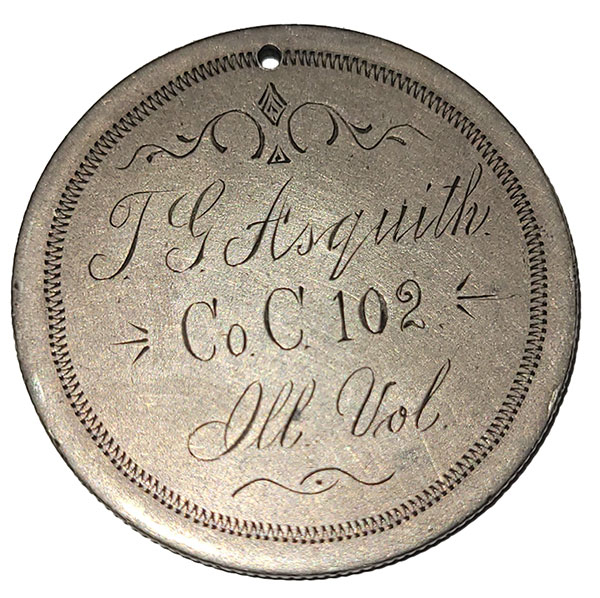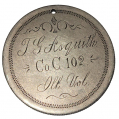site search
online catalog
CIVIL WAR VETERAN’S REGIMENTAL BADGE AND IDENTIFICATION DISK OF THEODORE G. ASQUITH, CO. C, 102nd ILLINOIS

$750.00 SOLD
Quantity Available: None
Item Code: 172-6074
This is a nice example of a jeweler-made identification badge for a veteran of the 102nd Illinois, a regiment with some extensive campaigning experience including the Atlanta Campaign, the March to the Sea, and the Campaign of the Carolinas. This is sort of a throwback to the “love tokens” of the 1850s, using a US coin, in this case an 1877 dated Seated Liberty half-dollar, by mounting a pin and hook on one side and smoothing off the other side for engraving. The coin shows a good deal of wear, but on the reverse of the badge the figure of Liberty with a Liberty Cap on a staff and a US shield by her side, with an arc of thirteen stars overhead is clear, as is the 1877 date at the bottom and the reeded edge. A smooth hole was drilled for suspension, but some solder stains show it also one had a pin and clasp. The other side was smoothed off and ric-rac border was created with the veteran’s name and unit engraved in thin script and block letters: T.G. Asquith / Co. C. 102. / Ill. Vol.” with flourishes at top, bottom and either side.
According to the 1860 census Theodore Garrison Asquith was born in England in 1841, though he later listed Pennsylvania as his birthplace. In 1860 he was living with his widowed mother and two brothers on a farm in Rock Island County, Illinois, with Hazlitt, Edgington Township, as a post office. He listed himself as a resident of Richland Grove, Mercer County, when he enlisted as on 8/13/62, mustering into Co. C of the 102nd Illinois on 9/2/62 to serve three years and survived to muster out 6/6/65 at Washington. He returned to Illinois, where he married in 1870, eventually rearing eight children, and moving to Iowa by the time of the birth of his fifth child in June 1880. Both he and his wife passed away in 1924.
The 102nd Illinois was organized at Knoxville in August 1862, and mustered into service Sept. 1 and 2. Dyer summarizes their service as follows: Moved to Peoria, Illinois, September 22, then to Louisville, Kentucky, October 1. March in pursuit of Bragg through Kentucky October 1–16, 1862. March to Gallatin, Tennessee, via Frankfort, Bowling Green, and Scottsville, Kentucky, October 16-November 26. Duty at Gallatin until June 6, 1863. Action at Woodbury April 27, 1863. Moved to Lavergne, Tennessee, and on railroad guard duty at Lavergne and Stewart's Creek until February 1864. (5 companies mounted August 1863.) Moved to Wauhatchie Valley, Tennessee, February 25, 1864. Scout from Lookout Valley to Deer Head Cove, Georgia, March 29–31. Atlanta Campaign May 1-September 8. Movement on Dalton May 5–8. Demonstration on Rocky Faced Ridge May 8–11. Battle of Resaca May 14–15. Near Cassville May 19. Advance on Dallas May 22–25. New Hope Church May 25. Operations on the line of Pumpkin Vine Creek and battles about Dallas, New Hope Church, and Allatoona Hills May 26-June 5. Big Shanty June 1. Operations about Marietta and against Kennesaw Mountain June 10-July 2. Pine Hill June 11–14. Lost Mountain June 15–17. Gilgal or Golgotha Church June 15. Muddy Creek June 17. Noyes Creek June 19. Kolb's Farm June 22. Assault on Kennesaw June 27. Ruff's Station, Smyrna Camp Ground, July 4. Chattahoochee River July 5–17. Peachtree Creek July 19–20. Siege of Atlanta July 22-August 25. Operations at Chattahoochie River Bridge August 26-September 2. Occupation of Atlanta September 2-November 15. March to the sea November 15-December 10. Occupation of Milledgeville November 22. Ogeechee River November 29. Siege of Savannah December 10–21. Carolinas Campaign January to April 1865. Occupation of Hardeeville January 3, 1865. Occupation of Lawtonville, South Carolina, February 2. Rockingham, North Carolina, March 7. Fayetteville, North Carolina, March 11. Averysboro, Taylor's Hole Creek, March 16. Battle of Bentonville March 19–21. Moccasin Creek March 24. Occupation of Goldsboro March 24. Advance on Raleigh April 10–14. Occupation of Raleigh April 14. Bennett's House April 26. Surrender of Johnston and his army. March to Washington, D.C., via Richmond, Virginia, April 30-May 19. Grand Review of the Armies, May 24.
The regiment lost 51 officers and men in killed and mortally wounded alone. The Union Army adds some particulars of their service starting in the Atlanta Campaign, during which they served in the 20th Army Corps: the regiment was engaged at Resaca on May 15, losing 3 killed and 19 wounded. The following day the brigade captured a battery from the enemy at Camp Creek, the regiment losing in the affair 18 killed, 6 mortally wounded and 70 wounded. They next encountered the enemy at Burnt Hickory on May 27 and were engaged for 4 days, losing 4 killed and 14 wounded. It was in action at Kennesaw on June 15 and 16 losing 13 wounded, and it was engaged at Peachtree Creek on July 20, where it lost 2 killed and 11 wounded. It participated in the March to the Sea and the campaign of the Carolinas, losing 2 killed and 19 wounded at Averysboro on March 16, 1865.
This is nice badge for a veteran with some active service. [sr][ph:L]
~~~~~~~~~~~~~~~~~~~~~~~~~~~~~~~~~~~
THIS ITEM, AS WITH ALL OTHER ITEMS AVAILABLE ON OUR WEB SITE,
MAY BE PURCHASED THROUGH OUR LAYAWAY PROGRAM.
CLICK HERE FOR OUR POLICIES AND TERMS.
THANK YOU!
Inquire About CIVIL WAR VETERAN’S REGIMENTAL BADGE AND IDENTIFICATION DISK OF THEODORE G. ASQUITH, CO. C, 102nd ILLINOIS
For inquiries, please email us at [email protected]
Most Popular
Historical Firearms Stolen From The National Civil War Museum In Harrisburg, Pa »
Theft From Gravesite Of Gen. John Reynolds »
Selection Of Unframed Prints By Don Troiani »
Fine Condition Brass Infantry Bugle Insignia »
British Imported, Confederate Used Bayonet »
Scarce New Model 1865 Sharps Still In Percussion Near Factory New »
featured item
THEFT REPORTED AT AUTUMN GETTYSBURG SHOW
A vendor at the Autumn Gettysburg Civil War show held at the Allstar Events Complex on Oct. 28-29 reported that a Maryland sword belt plate valued at $3500 was stolen from a display case on Sunday afternoon. The Gettysburg Times published a… . Learn More »
site search
Upcoming Events
May 16 - 18: N-SSA Spring Nationals, Fort Shenandoah, Winchester, VA Learn More »




